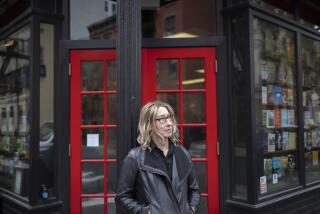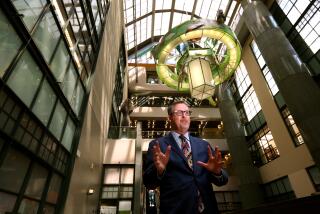Boom Echoes Of f the Clinton Library
- Share via
LITTLE ROCK, Ark. — More than 30,000 people are expected Thursday when former President Clinton opens his $165-million presidential library, and civic leaders say the campus is already functioning as a catalyst for a renaissance here, helping to spur a building boom.
The presidential library -- the nation’s 12th, and the largest private development in Little Rock history -- has been built on a 30-acre site that had housed abandoned warehouses and trash for as long as anyone can remember. Since Clinton announced in 1997 that he would build there, just east of downtown Little Rock, developers and corporations have launched $1 billion in construction and renovation projects, officials said.
City officials believe the library will have a lasting effect and become a major tourist draw, unlike most presidential libraries, which function more as scholarly centers.
“I was at the fitness center at 5:30 this morning,” Little Rock Mayor Jim Dailey said Friday. “There was not a single person in there who didn’t come up to me and say, ‘Big week ahead, Mayor.’ This library has become kind of an engine. It has provided the anchor for security -- for private and public dollars to flow into the downtown area in ways that simply would not have happened without it.”
Two years ago, for instance, Little Rock-based Heifer International, a nonprofit that fights hunger and poverty by developing sustainable economies, was looking to build new headquarters. The development promised to be a coup for the community that landed it. Heifer was well regarded and had grown tenfold in the previous decade. It was planning a $17-million facility, to be followed by a $64-million “global village” replete with a man-made mountain and grazing llamas.
With several locations in the running, including Chicago, Heifer did something that few large enterprises had done recently in Little Rock: It looked down the street for inspiration. There, on the south bank of the Arkansas River, Clinton was planning his library. Heifer not only stayed in Little Rock, its home since 1971, but moved in next door. Construction of the headquarters is underway today.
Little Rock has been on the rise for 10 years, and, chances are, a portion of the development boom would have occurred without the library. The city’s bustling River Market area, for example, was already gaining steam by the time Clinton made his announcement. But the library, said Tom Peterson, a Heifer vice president involved in developing its headquarters, “was the tipping point.”
“We would not have built here if it were not for the library,” he said. “From the scale of it to the approach they’re taking to help Little Rock and Arkansas, I just think it is making a world of difference here.”
On a recent rainy afternoon, Clinton Library Foundation President Skip Rutherford dashed through downtown Little Rock.
“That’s new,” he said, pointing to an office-supply building near the river that was turned into loft apartments.
“So are those,” he said, pointing to one of the city’s electric streetcars.
Near the library grounds, Acxiom Corp., a data warehousing company, recently opened a $25-million office building. More than 2,000 hotel rooms have been built or renovated, including a 120-room hotel that recently opened in the new $25-million First Security building, on what is now called President Clinton Avenue. The city’s bond rating jumped, and Standard & Poor’s pointed to the library as a foundation for the decision.
Little Rock, whose population of 183,000 makes it the largest city in Arkansas, has long reveled in its slow-paced, Southern gentility. The town boasts restored Italianate and Victorian homes, particularly in the fashionable Quapaw Quarter, and 19th century churches. It holds a locally famous holiday light show each year and proudly says that the cheese dog, a frankfurter injected with cheese, was invented at the Finkbeiner Meat Packing Co.
But the city is perhaps best known as the place where a governor tried to block nine black students from attending Central High School in 1957 -- an episode city leaders would rather forget.
The development boom has had a transformative effect on pockets of the city. Property values in some downtown areas have doubled or more, Dailey said. Unemployment in Little Rock is at 4.2%, better than the state and national rate. An eclectic collection of new restaurants and boutiques, including a craft shop where Clinton bought British Prime Minister Tony Blair’s Christmas gift a few years back, lines the riverfront.
“If you had to point to one particular event that was noteworthy in our plans for development in downtown Little Rock, it would be the Clinton library,” said Jimmy Moses, a prominent developer who has launched $90 million in upscale retail and residential development in the last five years. “This is a major anchor, and it is not going to be subject to economic whims. It will be there forever.”
City officials also point out that Little Rock now offers a cluster of nonprofit international development organizations. They include the library, where Clinton will oversee projects in foreign countries, such as efforts to combat AIDS, Heifer International and Winrock International, which promotes economic opportunity and agricultural productivity around the world.
The library’s development has not been without controversy.
Construction was held up briefly by a resident’s unsuccessful lawsuit alleging that the city illegally used public money to buy the land. A group of critics threatened to open a Counter Clinton Library dedicated to exposing his “left-wing political and social agenda.” And an advocacy group recently named Little Rock the nation’s “meanest” city when it comes to the homeless, in response to the city’s now-tabled plan to shut down 27 homeless camps before the library’s opening ceremony.
Rutherford, who has known Clinton since 1974, when the future president was a young law professor thinking about running for Congress, said the library’s plan was to draw about 300,000 tourists a year -- more than twice the number other presidential libraries typically attract. The goal, he said, is supported by the extensive research done by Clinton and his advisors.
Location, they determined, was key. After visiting several other presidential libraries, Clinton’s advisors found that many of them were in sentimental locations that are difficult to access -- such as the Ronald Reagan library, near Simi Valley. That’s one reason Clinton chose his spot near downtown Little Rock, close to Interstate 30 and the 41 million cars that pass by each year.
The library grounds also include the Clinton School of Public Service, an arm of the University of Arkansas. The school, built in a restored 1899 railroad station, is scheduled to accept its first class of 15 to 20 students in the fall of 2005, offering master’s degrees in public service. Rutherford said he expected the school would draw high-profile scholars and guest lecturers who would also take part in the library’s education programs.
More than anything, though, Little Rock is banking on Clinton himself to bring in the crowds and cement the city’s makeover.
“He is the youngest ex-president since Teddy Roosevelt,” Rutherford said. “His wife is in the Senate. They are the most interesting and intriguing political figures of our time. So the future is wide open.”
More to Read
Sign up for Essential California
The most important California stories and recommendations in your inbox every morning.
You may occasionally receive promotional content from the Los Angeles Times.











